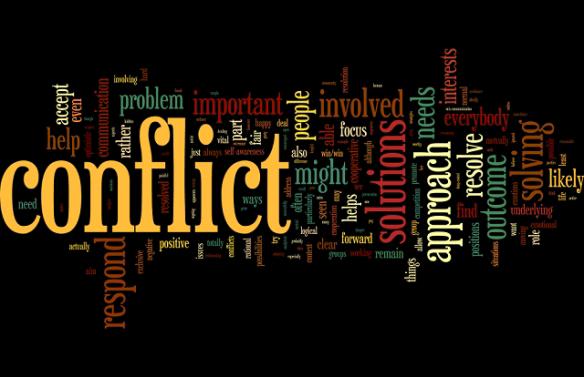Conflict DefinitionConflicts arise between people or groups when there is a difference in interest, viewpoints, or even philosophical concepts. There will always be conflict in society since it can have a variety of root causes including personal, racial, class, caste, political, and international. Academic recognition may or may not be a significant motivator in conflicts that are emotional, intellectual, or theoretical. Cultural conflict is a subclass of intellectual conflict, which tends to intensify over time because of various cultural norms and ideas. 
Conflict in a group frequently takes a predetermined path. Regular group interactions are first disrupted by an internal conflict, which is frequently brought on by conflicts among the group's members, internal disagreements, or a lack of resources. The group is no longer cohesive at this phase and may divide into coalitions. In some instances, this stage of conflict escalation is followed by a stage of conflict resolution, following which the group can either revert to regular group engagement or break apart. DefinitionAccording to M. Afzalur, a professor at Western Kentucky University, there isn't a single definition of conflict that is generally accepted. He says that all definitions of conflict require knowing conflicting interests and the process of attempting to stop the opposing view(s). Afzalur proposes the definition of conflict as "an interactive process manifested in incompatibility, disagreement, or dissonance inside or between social entities." Moreover, a dispute may just affect one person who is conflicted inside himself (the intrapersonal conflict). In addition to that, there is another type of conflict that happens between two people or groups (interpersonal conflict) which affects both the parties involved in the dispute. There are several examples of conflict behavior, starting with disagreement and moving on to interference and verbal abuse. Michael Nicholson, a professor of internal relations at the University of Sussex, offers another definition of conflict as an activity that occurs when aware people (individuals or groups) attempt to carry out mutually conflicting activities regarding their needs, wants, or commitments. It is distinguished by the presence of conflict behavior, in which individuals actively seek to harm one another. Emotional Factors Involved in Intergroup Conflict
The general opinion one's own group (in-group) has of another group (outgroup) is a significant factor in inter-group relations as well as conflict. If there are sentiments of discomfort when engaging with a member of a particular group which extends outright hatred for that other group and its members, this indicates that inter-group relations are very unhealthy. According to the stereotype content model, out-group-directed emotions have two characteristics that determine how they are expressed: the perceived friendliness (warmth) and competence of the other group (skillfulness). 1. Envy When the outgroup is thought to have high competence but low warmth, envy develops (Cuddy, Fiske & Glick, 2007). Typically, envious groups regard another group as competition because of its symbolic and material accomplishments (Forsyth, 2010). 2. Contempt When one judges the outgroup to be lacking in warmth and competence, contempt arises (Cuddy, Fiske & Glick, 2007). Forsyth claims that one of the most common intergroup emotions is contempt. In this case, the outgroup is made to take responsibility for its own mistakes. Members of the in-group also think that their disagreements with the outgroup will never be settled (Forsyth, 2010). 3. Pity Outgroups that the in-group perceives as being warm but lacking in competence are pitied (Cuddy, Fiske & Glick, 2007). Typically, pity groups have a lower standing than the in-group and are not held accountable for their shortcomings (Forsyth, 2010). 4. Admiration An outgroup is considered to be very competent and warm when adoration happens, yet admiration is relatively uncommon because these two characteristics are rarely met (Cuddy, Fiske & Glick, 2007). An appreciated outgroup is considered to be wholly deserving of its successes. When an in-group member can feel proud of the achievements of the outgroup and when the out-group does not conflict with the in-group, it is believed that admiration is most likely to develop (Forsyth, 2010). Conflict Types
There are a number of different types of conflict that arise among people. When there is intragroup conflict, at least one member of the group's aims is at odds with the group's overall objectives. Interpersonal conflict, or conflict between two or more people, can also be a result of differences in opinions and beliefs. Following is the list of categories of conflict:
The conflicts listed below can either be intragroup or intergroup:
However, in some situations (like competition in sports), varying levels of conflict can be seen as mutually beneficial and promote understanding, tolerance, learning, and effectiveness. Conflict is rarely seen as constructive. The group can learn to resolve intragroup conflict in a team context, which would lead to decreasing undesirable consequences. Good outcomes improve with increased teamwork, collaboration, and understanding among colleagues, which finally results in the control of an intragroup conflict. Ideas Leading to ConflictIn their 2003 study, Roy and Judy Eidelson looked into some of the significant roles that ideas may have in either causing or preventing conflict across groups. A survey of the pertinent literature reveals five belief areas that stand out as particularly significant: superiority, unfairness, susceptibility, mistrust, and helplessness. i) SuperiorityThe core idea at the individual level: This is the idea that an individual is superior to everyone else and, consequently, many social frameworks because the person perceives their own thinking as "privileged" and, as a result, does not get along with others. Individuals who hold this idea frequently exhibit "specialness, deservingness, and entitlement" attitudes. 
Group-level worldview: Most ideas remain the same when transitioning from the individual-level core belief to the group-level worldview. The main distinction is that these views relate to huge groups rather than single people. One illustration of this is "ethnocentric monoculturalism," which refers to the idea that one's own cultural legacy is superior to that of others. ii) UnfairnessThe core idea at the individual level: This idea is that someone has been treated unfairly, and it has had a significant negative impact on them. The most common interpretation of this mistreatment is "disappointment and betrayal". Group-level worldview: This is where the superiority group level is directed. For the same reasons that an individual takes offense at another, this group takes offense at another group for alleged mistreatment, betrayal, and perceived injustices. iii) VulnerabilityThe core idea at the individual level: Consider a person whose anxiety never goes away. It occurs when a person feels out of control and as though they are "perpetually in danger's way." Group-level worldview: A group's sense of vulnerability stems from a projected threat in the future, according to their collective worldview. The group can then "target group behavior in specific directions that include animosity" as their bonds are strengthened. iv) DistrustThe core idea at the individual level: This is predicated on "assumed animosity and malignant intent seen in others." It encourages antagonistic behavior and hinders the development of wholesome relationships. Group-level worldview: This causes a permanent division between the in-group and the outgroup because the in-group creates a stereotype of the outgroup that must be refuted by the outgroup. v) HelplessnessThe core idea at the individual level: A steadfast conviction that whatever an individual does, the results will not be favorable. As if the person "lacks the requisite ability," as if they did not receive enough support, or as if their surroundings are hostile. Group-level worldview: A group's shared assumptions about dependence and helplessness are referred to as its worldview. This also illustrates how much room there is for growth. Factors Causing Escalation of ConflictEven though the parties involved in a conflict may want to resolve it quickly, psychological and interpersonal issues might thwart their efforts, which in turn leads to conflict escalation. Escalation of a conflict "may be seen as an increase in a conflict with respect to the extent observed and the means employed." The escalation of the conflict is fueled by a number of variables, including a stronger commitment to one's side, the adoption of more aggressive persuasion techniques, and the building of coalitions. i) Confidence and CommitmentGroup members' doubts and misgivings are replaced with a firm dedication to their perspective when conflicts worsen. Humans defend their decisions after they have been made by seeking evidence that validates their beliefs, rejecting information that contradicts their beliefs, and solidifying their initial position. Many also think that once they publicly choose a position, they should stick with it. They may occasionally be aware of the flaws in their arguments, but they nonetheless insist on defending them in order to look good. Finally, if the opposing side makes an overly forceful argument, reactance may set in, and the group may grow even more adamant about its stance. ii) Confusion and PerceptionPerception is a very important aspect of conflict escalation. The way that people view the conflict and the people involved will affect how they react to it. Conflict tends to greatly skew the opponents' perceptions of each other's attitudes, values, and character traits. Confusion also plays a major role in building up disputes as the groups or parties tend to believe what they see, letting their observation blur their judgement. This results in contradicting opinions and confusion between groups. iii) MisattributionOpposing groups, in order to prove themselves right, tend to present the situations in such a manner that represents them as the hero and the rival group as the villain, this is known as misattribution. People describe the conduct of their adversaries during the fight in ways that exacerbate the issue. When one assumes that situational (environmental) rather than personal (dispositional) variables contributed to an opponent's behavior, they are making a fundamental attribution error. In this type of conflict escalation, parties may come to the conclusion that it cannot be resolved. Intractable confrontations are typically anticipated to be drawn out, passionate, and very difficult to resolve. iv) Misinterpreting MotivesDuring a fight, parties frequently grow distrustful of one another and question whether their initial cooperative goals have been supplanted by competing ones. It is challenging to rebuild the cooperative partnership after this betrayal. While there isn't actually a competition taking place, they frequently believe that others are in it with them. Competitors also tend to be more prejudiced in their pursuit of data that supports their presumptions about other competitors. They frequently profess to be more cooperatively oriented than they actually are, and they also have a tendency to intentionally misrepresent their objectives. Conflict Resolution
As a social process, conflict is aggravated when one or more group members choose a side in the argument. A group member who is not currently involved in the issue can mediate the conflict as one way to resolve it. A mediator is described as a person who intervenes in a quarrel between two group members to mediate a resolution. Simply expressed, the mediator serves as an impartial facilitator who leads the parties to a dispute through the process of finding a resolution (Forsyth, 2010). Although there will typically be a propensity for group members who are not directly involved in the disagreement to stay that way, there are some situations when the conflict may get so intense that mediation becomes necessary. Conflict resolution through third-party mediation creates channels for dialogue between disputing group members. Members are free to voice their thoughts and ask other members for clarification on their positions, with the mediator serving as a sort of defense against any embarrassment or "loss of face" that either disputant may feel. The mediator can help participants refine their ideas and make counteroffers to one another, as well as change the time and place of meetings to make them mutually agreeable for all parties (Forsyth, 2010). Three Main Mediation Strategies1. Inquisitorial Technique The mediator uses the inquisitorial technique, in which he or she poses a series of questions to each party in the dispute, weighs their responses, chooses one, and forces it on the other parties. The least used method of mediation is the inquisitorial procedure. 2. Arbitration In this case, mediation entails the two parties stating their positions to the mediator, who then develops a resolution based on those positions. Although arbitration is generally the preferred mediation method, it works best for low-intensity disputes. 3. Moot The moot approach entails an open debate about the issues and potential solutions between the disputing parties and the mediator. The mediator is unable to impose a binding resolution when using the moot method. A moot is the ideal mediation format after arbitration. Why Conflict ResolutionConflict resolution is important as it offers a number of benefits to society. When there is a conflict between social groups, an attempt towards conflict resolution may offer a better understanding of both sides and why they have chosen the side they have chosen. 
Individuals' reactions to the conflict are shaped by their perception of the situation and the people in the situation. During the conflict, opponents' inferences about each other's strengths, attitudes, values, and personal qualities tend to be largely distorted. Conflict resolution can be a way to mend the image of the rival group in the minds of the other group by clarifying their perspectives and eliminating confusion and resentment. During the conflict, people explain their opponents' actions in ways that make the problem worse. Conflict resolution can also offer a better explanation of the actions of both groups so that the possibility of misattribution can be eliminated and conflict becomes easier to deal with. ConclusionConflict is in some way necessary for society to function properly as it provides room for understanding, effective decision making and prolonged discussion which help in understanding people or groups in a better way. But, it is no doubt that conflict, if not resolved easily, leads to disputes that can sometimes even stretch to verbal and physical abuse. Thus, even though conflict is found effective, it should be resolved at its earliest.
Next TopicKinetic Energy Definition
|
 For Videos Join Our Youtube Channel: Join Now
For Videos Join Our Youtube Channel: Join Now
Feedback
- Send your Feedback to [email protected]
Help Others, Please Share










